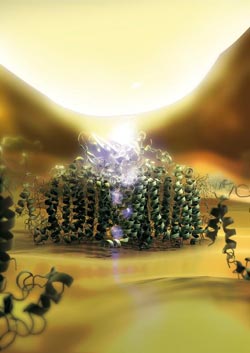Individual protein complex generates electric currents: Solar cell consisting of a single molecule

Photosystem-I (green) is optically excited by an electrode (on top). An electron then is transferred step by step in only 16 nanoseconds.<br><br>Photo: Chair E 20/ TUM<br>
The scientists could demonstrate that such a system can be integrated and selectively addressed in artificial photovoltaic device architectures while retaining their biomolecular functional properties. The proteins represent light-driven, highly efficient single-molecule electron pumps that can act as current generators in nanoscale electric circuits.
The interdisciplinary team publishes the results in ´Nature Nanotechnology´ this week.
The scientist investigated the photosystem-I reaction center which is a chlorophyll protein complex located in membranes of chloroplasts from cyanobacteria. Plants, algae and bacteria use photosynthesis to convert solar energy into chemical energy. The initial stages of this process – where light is absorbed and energy and electrons are transferred – are mediated by photosynthetic proteins composed of chlorophyll and carotenoid complexes. Until now, none of the available methods were sensitive enough to measure photocurrents generated by a single protein. Photosystem-I exhibits outstanding optoelectronic properties found only in photosynthetic systems. The nanoscale dimension further makes the photosystem-I a promising unit for applications in molecular optoelectronics.
The first challenge the physicists had to master was the development of a method to electrically contact single molecules in strong optical fields. The central element of the realized nanodevice are photosynthetic proteins self-assembled and covalently bound to a gold electrode via cysteine mutation groups. The photocurrent was measured by means of a gold-covered glass tip employed in a scanning near-field optical microscopy set-up. The photosynthetic proteins are optically excited by a photon flux guided through the tetrahedral tip that at the same time provides the electrical contact. With this technique, the physicists were able to monitor the photocurrent generated in single protein units.
The research was supported by the German Research Foundation (DFG) via the SPP 1243 (grants HO 3324/2 and RE 2592/2), the Excellence Clusters Munich Centre for Advanced Photonics and Nanosystems Initiative Munich, as well as ERC Advanced GrantMolArt (no. 47299).
Original publication:
Photocurrent of a single photosynthetic protein
Daniel Gerster, Joachim Reichert, Hai Bi, Johannes V. Barth, Simone M. Kaniber, Alexander W. Holleitner, Iris Visoly-Fisher, Shlomi Sergani, and Itai Carmeli
Links: http://dx.doi.org/
http://www.nature.com/
Contact:
Dr. Joachim Reichert,
Technische Universitaet Muenchen
Physik-Department E20
James-Franck Strasse, D-85748 Garching, Germany
Tel.: +49 89 289 12443 – Fax:+49 89 289 12338
E-Mail: joachim.reichert@tum.de – Internet: http://www.e20.ph.tum.de/
Prof. Alexander W. Holleitner
Technische Universitaet Muenchen
Walter Schottky Institut – Zentrum für Nanotechnologie und Nanomaterialien
Am Coulombwall 4a, 85748 Garching, Germany
Tel.: +49 89 289 11575 – Fax: +49 89 289 12600
E-Mail: holleitner@wsi.tum.de – Internet: http://www.wsi.tum.de
Dr. Itai Carmeli
Tel Aviv University
Center for NanoScience and Nanotechnology and School of Chemistry,
Tel Aviv 69978, Israel.
Tel.: +972-3-6405704 – Fax: +972-3-6405612
E-Mail: itai@post.tau.ac.il – Internet: http://www.tau.ac.il
Media Contact
All latest news from the category: Physics and Astronomy
This area deals with the fundamental laws and building blocks of nature and how they interact, the properties and the behavior of matter, and research into space and time and their structures.
innovations-report provides in-depth reports and articles on subjects such as astrophysics, laser technologies, nuclear, quantum, particle and solid-state physics, nanotechnologies, planetary research and findings (Mars, Venus) and developments related to the Hubble Telescope.
Newest articles

Silicon Carbide Innovation Alliance to drive industrial-scale semiconductor work
Known for its ability to withstand extreme environments and high voltages, silicon carbide (SiC) is a semiconducting material made up of silicon and carbon atoms arranged into crystals that is…

New SPECT/CT technique shows impressive biomarker identification
…offers increased access for prostate cancer patients. A novel SPECT/CT acquisition method can accurately detect radiopharmaceutical biodistribution in a convenient manner for prostate cancer patients, opening the door for more…

How 3D printers can give robots a soft touch
Soft skin coverings and touch sensors have emerged as a promising feature for robots that are both safer and more intuitive for human interaction, but they are expensive and difficult…





















